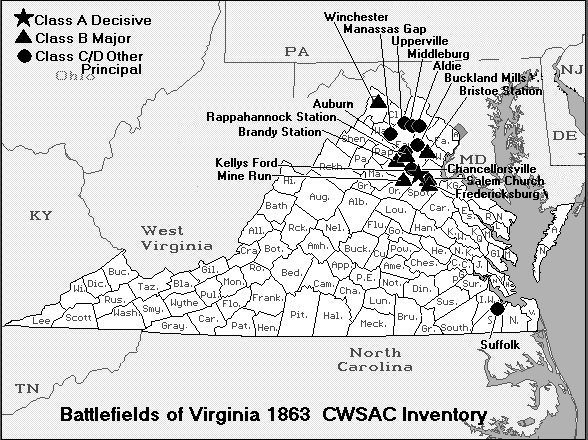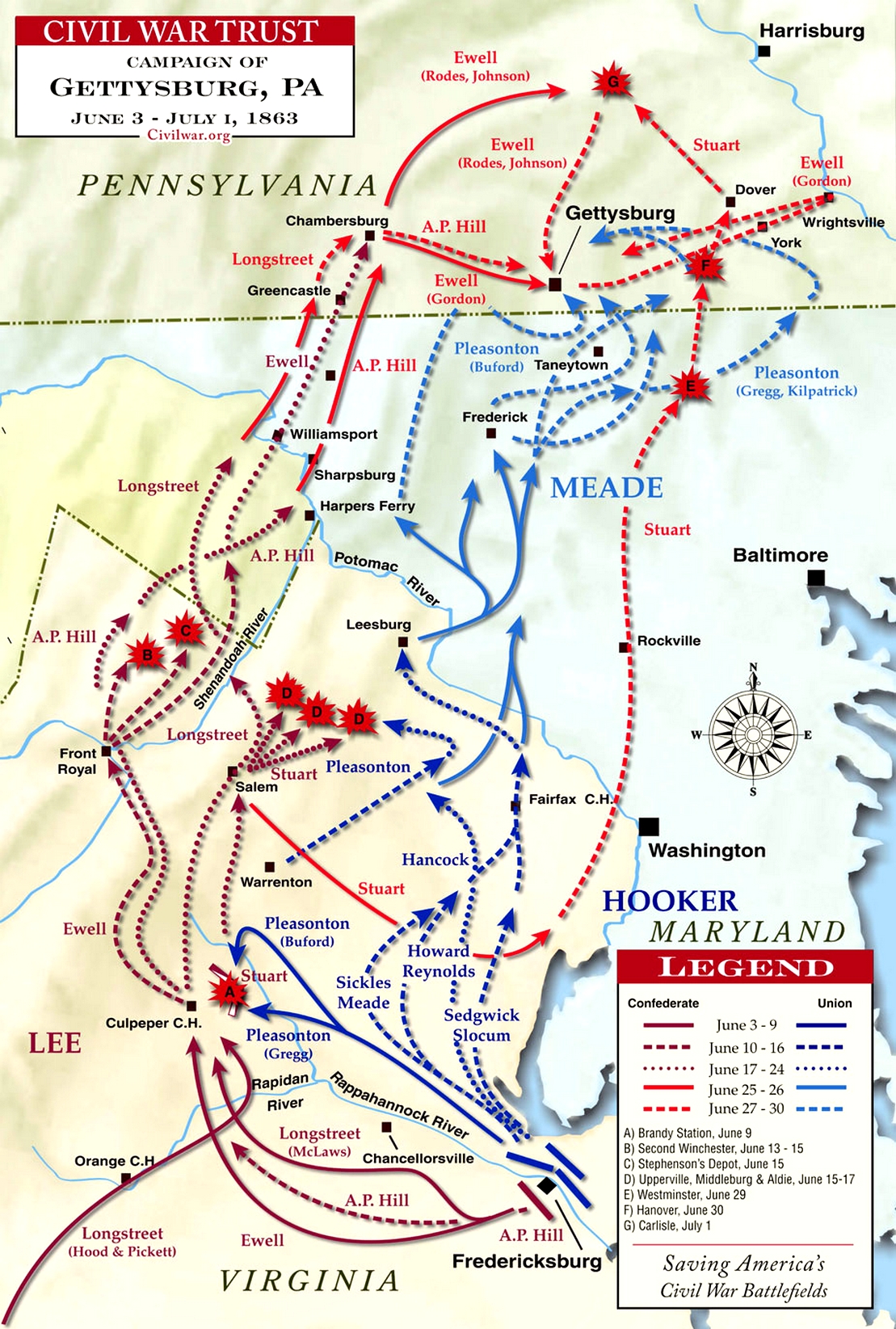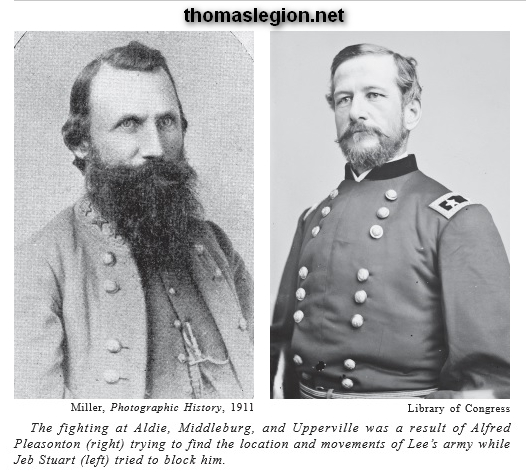|
Battle of Aldie
Aldie Civil War History
Battle of Aldie
Other Names: None
Location: Loudoun County, Pennsylvania
Campaign: Gettysburg Campaign (June-July 1863)
Date(s): June 17,
1863
Principal Commanders: Brig. Gen. Judson Kilpatrick [US]; Col.
Thomas Munford [CS]
Forces Engaged: Brigades
Estimated Casualties: 415 total
Result(s): Inconclusive
| Battle of Aldie Map |

|
| Civil War Battle of Aldie and Battlefield Map |
Introduction: Stuart’s cavalry screened the Confederate
infantry as it marched north behind the sheltering Blue Ridge. The pursuing Federals of Kilpatrick’s brigade, in the
advance of Gregg’s division, encountered Munford’s troopers near the village of Aldie, resulting in four hours
of stubborn fighting. Both sides made mounted assaults by regiments and squadrons. Kilpatrick was reinforced in the afternoon,
and Munford withdrew toward Middleburg.
Background: Late in the spring of 1863 tensions grew between Union commander Joseph Hooker
and his cavalry commander Brig. Gen. Alfred Pleasonton because of the latter's inability to penetrate Maj. Gen. J.E.B. Stuart's
cavalry screen and gain access to the Shenandoah Valley to locate the Army of Northern Virginia, which had been on the move
since the Battle of Chancellorsville in early May. On June 17, Pleasonton decided to push through Stuart's screen. To accomplish
his goal he ordered Brig. Gen. David McM. Gregg's division from Manassas Junction westward down the Little River Turnpike
to Aldie. Aldie was tactically important in that near the village the Little River Turnpike intersected both the Ashby's Gap
Turnpike and Snicker's Gap Turnpike, which respectively lead through Ashby's Gap and Snickers Gap of the Blue Ridge Mountain
into the Valley.
Battle: Early that very same morning, Colonel Munford led the 2nd and 3rd Virginia Cavalry
eastward across the Loudoun Valley from Upperville through Middleburg to Aldie on the Bull Run Mountains on a reconnaissance
and forage mission. He established a line of pickets in Aldie to watch for enemy activity and withdrew his two regiments northwest
of town on the Snicker's Gap Turnpike to camp on the farm of Franklin Carter.
About 4 p.m., Gregg's advance column of the 2nd and 4th New York, 6th Ohio, 1st Maine, 1st Rhode Island, and
1st Massachusetts, under the command of Brig. Gen. Judson Kilpatrick arrived in Aldie. Just west of the village the 1st Massachusetts
encountered Munford's pickets and drove them back. Around the same time, the rest of Munford's brigade (the 1st, 4th, and
5th Virginia Cavalry, under the command of Col. Williams Carter Wickham) arrived at Dover Mills, a small hamlet on the Little
River west of Aldie. Wickham ordered Col. Thomas L. Rosser to take the 5th Virginia to locate a campsite closer to Aldie.
As they moved east they ran into the Massachusetts men and easily drove them back through Aldie to the main Union body. After
positioning his sharpshooters (50 men of Company I under Capt. Reuben F. Boston) east of the William Adam farmhouse, Rosser
deployed west along a ridge that covered the two roads leading out of Aldie and awaited the arrival of the Federals, as well
as Munford and Wickham. As Rosser withdrew west, the 1st Massachusetts, with aid from the 4th New York, charged against what
they believed to be a retreat. Rosser's line held and he mounted a countercharge in concert with a sharp volley from the sharpshooters
he had placed on his left and easily drove the Federals back, securing his hold on the Ashby's Gap Turnpike.
Kilpatrick then turned his attention towards the Snicker's Gap Turnpike. An artillery duel ensued and more
cavalry on both sides soon arrived. A furious fight erupted, which at first went in favor of Munford as Federal charges were
met, stopped, and then forced back by the withering volley of sharpshooters entrenched along a stone wall. The 1st Massachusetts
Cavalry was trapped in a blind curve on the Snicker's Gap Turnpike and was destroyed, losing 198 of 294 men in the eight companies
that were engaged. One detachment under Henry Lee Higginson was virtually wiped out in hand-to-hand fighting. The tide finally
turned as Union reinforcements charged into the fray in the fading light and the 6th Ohio overran Boston's detachment on the
Ashby's Gap Turnpike, capturing or killing most of his men. The fighting died down around 8 p.m. as Munford withdrew his command
west towards Middleburg.
| Battle of Aldie |

|
| Battle of Aldie was fought during the Gettysburg Campaign |
Aftermath: Munford did not consider Aldie as a defeat as his withdrawal coincided with an
order from Stuart to retire, as more Federal cavalry had been sighted at Middleburg. Union casualties were 305 dead and wounded,
with the Confederates losing between 110 and 119. Aldie was the first in a series of small battles along the Ashby's Gap Turnpike
in which Stuart's forces successfully delayed Pleasonton's thrust across the Loudoun Valley, depriving him of the opportunity
to locate Lee's army.
Analysis: The opening battle of the Gettysburg campaign, Brandy Station,
and the climactic battle at Gettysburg have eclipsed the intervening cavalry battles of Aldie, Middleburg, and Upperville
in the history books. But the fight for Loudoun Valley was significant on a number of levels. Considered individually,
each battle might not rank high in terms of forces engaged and casualties. Considered together, however, it is clear
that the week’s fighting represented a substantial effort on both sides. At various times, Maj. Gen. J.E.B. Stuart
committed each of his five brigades, numbering near 9,000 troopers, to the task of defending the Blue Ridge Mountain gaps.
Brig. Gen. Alfred Pleasonton eventually pushed all of his available 8,000 men into the task of penetrating the Confederate
cavalry screen and, in addition, called on infantry support. Altogether some 19,000 soldiers struggled in the valley
from June 17-21.

|
| (L) Stuart; (R) Pleasonton |
The cavalry battle of Brandy Station yielded 1,400 casualties from among 21,000 engaged. Only eight
days later the adversaries met again on very different terrain. The steep-banked streams, ravines, stonewalled fields,
and constricted roads of Loudoun Valley prevented the extensive troop deployments and open maneuvering seen at Brandy.
At Brandy Station combat was concentrated in time and spread out over the open fields. In Loudoun Valley a comparable
intensity of effort was concentrated along fairly restricted corridors of movement and spread out over five days. Although
records are incomplete, historians have estimated combined casualties for Aldie, Middleburg, and Upperville as 1,360 (850
Northerners and 510 Southerners) with roughly similar losses among the mounts—an attrition of 8 percent of the forces
engaged. Brandy Station was the largest cavalry battle thus far in the war, but the week’s fighting in Loudoun
Valley drained an equivalent number of men and mounts from the ranks.
Loudoun Valley also witnessed a struggle of wills that permeated future cavalry operations in Virginia.
Stuart’s adjutant Henry B. McClellan wrote, “The battle of Brandy Station made the Federal Cavalry. The
fact is that up to June 9, 1863, the Confederate cavalry did have its own way... and the record of its success becomes almost
monotonous... But after that time we held our ground only by hard fighting.” It is true that the Union troopers
had been remarkably buoyed by their performance at Brandy Station, but in Loudoun Valley they proved to an attentive public,
to themselves, and to their adversary that Brandy had been no fluke. Once derided as hopelessly outclassed by Stuart’s
cavaliers, the Federal horsemen aggressively took “hard fighting” to their enemy with an offensive spirit hitherto
lacking. If Brandy Station marked the coming of age of the Federal cavalrymen as so many have observed, then the battles
for Loudoun Valley proved their newfound confidence. Stuart’s troopers, for their part, had to begrudge the fact
that they now faced a foe that matched them steel for steel.
In mid-June 1863, Maj. Gen. J.E.B. Stuart faced the task of defending the principal gaps in the Blue Ridge—Ashby’s
Gap and Snicker’s Gap—against Brig. Gen. Alfred Pleasonton’s Federal divisions. The two turnpikes
leading across Loudoun Valley to the gaps diverged at Aldie, complicating Stuart’s mission. Pleasonton could concentrate
his full force on either turnpike, while Stuart had to spread out his forces to cover both. The danger for Stuart was
that his brigades could become isolated from one another and defeated one at a time. The general nature of the terrain,
though, favored Stuart’s defense. Federal mobility was fairly closely restricted to the roads by the numerous
streams, stone walls, and fences that crisscrossed the landscape. The stone walls provided Stuart’s dismounted
skirmishers with readymade fortifications. Stuart selected his defensive positions carefully and could afford to give
up ground in a series of delaying actions. Pleasonton, on the other hand, had no choice but to attack each successive
position that he encountered. To accomplish his own mission—to discover the whereabouts of the infantry columns
of General Robert E. Lee’s Army of Northern Virginia--Pleasonton had to pierce the Confederate cavalry screen.
Much of the cavalry fighting in Loudoun Valley was dismounted. Troopers fanned out on foot (with every
fourth man holding the horses in the rear) to locate their opponents and test their strength. Mounted units were held
in reserve to exploit any weakness that might be uncovered. At Aldie, and again at Middleburg, the Confederates relied
heavily on the tactic of dismounting sharpshooters behind stone walls and ambushing the Federals at point-blank range.
Federal commanders had limited tactical options and tried them all. They could extend their lines beyond the Confederates’
flanks and maneuver them out of position; they could mass a deadly concentration of artillery fire to drive the defenders
off; or they could bull their way up the road in a mounted assault. Even if momentarily successful, they could expect
an equally determined mounted counterattack, and the momentum could swing abruptly to the other side. While there was
much dismounted fighting, these battles featured a great deal of what can only be called stubborn brawling—the kind
of stirrup-to-stirrup mounted combat with saber and pistol that took a deadly toll of men and mounts.
As the war dragged on, the saber charges of Brandy Station and of Aldie, Middleburg, and Upperville became
increasingly rare as units of both sides forsook cold steel for carbines and repeating rifles. But in June 1863, the
thunderous mounted assault embodied all the dash and chivalry that yet adhered to the cavalry arm. See also Pennsylvania Civil War History.
Advance to:
Sources: National Park Service; Civil War Trust; civilwar.org; Head, James W. History and Comprehensive
Description of Loudoun County Virginia. Washington, DC: Parkview Press, 1908. OCLC 1837578; O'Neill, Robert F. The Cavalry
Battles of Aldie, Middleburg and Upperville: Small But Important Riots, June 10–27, 1863. Lynchburg, VA: H.E. Howard,
1993. ISBN 1-56190-052-4; Salmon, John S. The Official Virginia Civil War Battlefield Guide. Mechanicsburg, PA: Stackpole
Books, 2001. ISBN 0-8117-2868-4.
|

